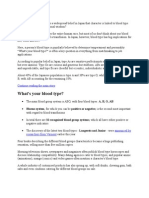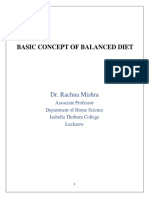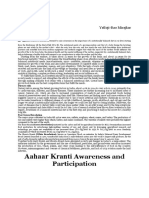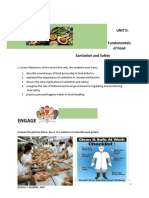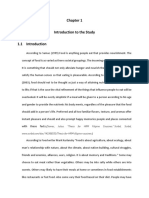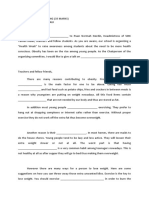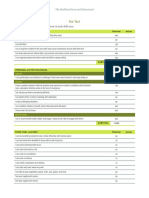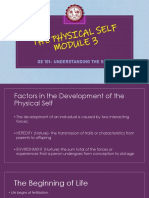0 ratings0% found this document useful (0 votes)
11 viewsIndian Diet
Indian Diet
Uploaded by
Dharmendra SinghThe document discusses the Aahaar Kranti initiative which aims to promote nutritional awareness in India. It explains the importance of a balanced diet at different stages of life from pregnancy to old age, for both vegetarians and non-vegetarians. Experts provide guidance on macronutrient and micronutrient requirements. The focus on locally sourced fruits and vegetables is also discussed.
Copyright:
© All Rights Reserved
Available Formats
Download as DOCX, PDF, TXT or read online from Scribd
Indian Diet
Indian Diet
Uploaded by
Dharmendra Singh0 ratings0% found this document useful (0 votes)
11 views4 pagesThe document discusses the Aahaar Kranti initiative which aims to promote nutritional awareness in India. It explains the importance of a balanced diet at different stages of life from pregnancy to old age, for both vegetarians and non-vegetarians. Experts provide guidance on macronutrient and micronutrient requirements. The focus on locally sourced fruits and vegetables is also discussed.
Original Title
indian diet
Copyright
© © All Rights Reserved
Available Formats
DOCX, PDF, TXT or read online from Scribd
Share this document
Did you find this document useful?
Is this content inappropriate?
The document discusses the Aahaar Kranti initiative which aims to promote nutritional awareness in India. It explains the importance of a balanced diet at different stages of life from pregnancy to old age, for both vegetarians and non-vegetarians. Experts provide guidance on macronutrient and micronutrient requirements. The focus on locally sourced fruits and vegetables is also discussed.
Copyright:
© All Rights Reserved
Available Formats
Download as DOCX, PDF, TXT or read online from Scribd
Download as docx, pdf, or txt
0 ratings0% found this document useful (0 votes)
11 views4 pagesIndian Diet
Indian Diet
Uploaded by
Dharmendra SinghThe document discusses the Aahaar Kranti initiative which aims to promote nutritional awareness in India. It explains the importance of a balanced diet at different stages of life from pregnancy to old age, for both vegetarians and non-vegetarians. Experts provide guidance on macronutrient and micronutrient requirements. The focus on locally sourced fruits and vegetables is also discussed.
Copyright:
© All Rights Reserved
Available Formats
Download as DOCX, PDF, TXT or read online from Scribd
Download as docx, pdf, or txt
You are on page 1of 4
J ust imagine a pendulum in your mind oscillating between what I would like to eat and what I should eat?
eat? And when you give
it a thought, you know there has to be a balance in what you eat, and the pendulum must stop at the centre. But the pendulum
almost always stops on the side where you decide to eat what you like. Most striking part is that we know it is wrong but we fail to
alter it. Sometimes you can listen to your heart when it comes to food but not always.
To help and guide you in the right decision making, here comes the ‘Aahaar Kranti’ for the well being of each one of us. It aims to
create nutritional awareness in all sections of our society.
It is an indigenous initiative made by Vijnana Bharati and Global Indian Scientists’ and Technocrats’ Forum ( GIST). They have come together to
launch the programme Aahaar Kranti, with the motto-Uttam Aahaar, Uttam Vichaar. Aahaar Kranti Initiative is also supported by Council of
Scientific and Industrial Research (CSIR)’s Pravasi Bharatiya Academic and Scientific Sampark (Prabhaas) and various central and state
government ministries and agencies.
Uttam Aahaar is one that provides all nutrients in required amount and proportions for maintaining good health and general well
being and makes small provision for extra nutrients to withstand short duration of illness. A balanced diet which provides all the
nutrients is needed throughout our lives at all ages. They must be obtained through a judicious choice and
combination of a variety of foodstuffs from different food groups.
Aahaar Kranti initiative will help you understand the basic concept of balanced diet which includes
macronutrients that are required in large amounts like carbohydrates, fats and proteins and micronutrients that
are required in small quantities like vitamins and minerals. These nutrients are necessary for the human body to
acquire, assimilate and utilize food to maintain health and activity.
Balanced Diet Mantra
Dr Seema Puri, Associate Professor from Department of Nutrition at Institute of Home Economics in University of Delhi
mentions three Mantras that matter with food: Balance, variety and moderation.”
These mantras must be inculcated in our lives from birth or from early childhood. We all need nutrition, but
early childhood needs proper nutrition investment.
Dr Alok Kumar Agarwal, Consultant Paediatrician at Lal Bahadur Shastri hospital emphasises that, “Proper
nutrition in first 1000 days (270 days of pregnancy and 2 years, i.e., 730 days of child’s life) have permanent
bearing on the health of the individual throughout life. Exclusive breast feeding for first 6 months after birth
followed by proper complimentary feeding is very crucial for developing brain. By one year of age, the child
should be eating around 250 ml, 4-5 times per day from family pot. This should provide around 1000-1200 kcal
along with 15-20 gram of proteins. By 10-16 years of age, a child requires 2100-2700 kcal from diet which should
include 54-78 gram of proteins, 500-600 mg of calcium and 30-50 mg of iron. This varies with age and physical
activity level of the child. Children undernourished during this period are far more likely to suffer from long-term
health problems, poorer educational performance, and lower economic prosperity.”
It all begins even before the birth of a child when we take care of a would-be mother. So, during pregnancy a woman
should eat the best. That is why it is often said and believed that a pregnant woman should eat for two.
But, Dr Puri clarifies, “While nutritional requirements of pregnant women increase during pregnancy, the
increase is not double and varies during the course of pregnancy. During the first trimester there is a greater need
for proteins and micronutrients for development of organs. During the third trimester, emphasis is on increasing
the birthweight of the baby, so the mother should have higher energy diets or foods like panjiri.”
She also mentions that too much tea or coffee could provide substantial amounts of caffeine which is detrimental to
the development of the baby and therefore should be avoided.
Dr Agarwal strictly warns that “Junk food including cold drinks, burgers, fries should best be avoided as they
give empty calories in the form of carbohydrates and fats only, thus leading to obesity.”
Balanced Diet and gender
Making the right choice of food is most important. As a child always needs assistance to understand and build good
eating habits, it is our responsibility to guide them. But being an adult, what do we understand about our diet. Let’s start
with the basics of what differs in diet of a man and woman.
Dr. Hemalatha R., Director of ICMR-National Institute of Nutrition in Hyderabad explains, “The definition of
balanced diet remains same for both genders. However, the nutrient requirement varies with age, gender, activity
and physiological status. To meet
of each food group needs to be changed.”
She also decodes the science of calorie intake based on gender. “A sedentary adult man requires 2110 Kcal and a
sedentary woman requires 1660 Kcal. Though the calorie requirement is lesser for women, their micronutrient
requirement may be higher. For instance the iron requirement for adult men is 11mg/day while it is 15 mg/day for
adult women and 21 mg/day during pregnancy. Similarly, during lactation the calcium requirement of women
becomes higher.”
Balanced diet and ageing
If we understand the concept of balanced eating, the purpose of Aahaar Kranti will be fulfilled. This revolutionary
programme aims at well being of all age groups. Because, a healthy child develops into a healthy adult and in turn has a
healthy ageing.
Dr Hemalatha R. explains, “In elderly people metabolism is altered and also their food consumption is affected
due to various factors. Due to decreased food
is compromised along with their muscle mass. Though the calorie requirement is less due to decreased physical activity,
their requirement of protein and micronutrients, especially vitamin D and calcium, remains higher.”
So, how can the elderly meet these requirements? Dr Hemalatha suggests, “they should include fresh foods, fruits and milk in
their daily diet. Their diet should be made soft, easily digestible and palatable. In addition to the diet regular physical activity is
important to retain muscle mass and utilize the micronutrients obtained from diet or supplements.”
Another aspect of balanced diet is how it differs for a vegetarian and a non-vegetarian. Dr Hemalatha says, “While
the definition of balanced diet remains same for both vegetarians and non-vegetarians, only the source of protein
varies. The vegetarians can obtain protein from pulses, legumes regularly while non-vegetarians can exchange
one portion of these with flesh foods or
eggs or fishes. Fish can be consumed 2-3 times in a week. Apart from these food groups, milk and milk
products are rich sources of protein for both vegetarians and non vegetarians.
The UN General Assembly has designated 2021 the International Year of Fruits and Vegetables ( IYFV). Aahaar
Kranti initiative will renew the focus on nutritionally balanced diets-Uttam evam santulit aahaar replete in
locally sourced fruits and vegetables. Fresh fruits and vegetables provide nutrients for energy and health
maintenance, and to combat disease. Describing the role of fruits and vegetables in our diet, Dr Hemalatha
explains that “Fruits and vegetables are essential sources of micronutrients such as Vitamins and Minerals and
fibre while being low in calories. Vegetables have complex carbohydrates that make them low in Glycemic Index,
which prevents spike in blood glucose level. The high fibre content improves the gut microflora and aids immune
function. Fruits and vegetables are also rich in phytochemicals that have antioxidant functions and protect our
body from degenerative diseases.”
Fruits and vegetables constitute one of the three food groups in the balanced diet. These are the protective food
group, i.e., these foods are rich in micronutrients and help in building immunity, maintain eyes, skin, lips, etc.
and protect from infections, e.g. They have vitamin A, vitamin D etc. The more colour more beneficial they are.
WHO has run a campaign, The 5 A Day, which recommends eating a minimum of 400 gram of fruit and
vegetables a day to lower the risk of serious health problems, such as heart disease, stroke and some types of
cancer.
Dr Puri, gives a simple message, “Eat 5 different coloured fruits and vegetables everyday”. She even discards the general
belief of not eating fruits and vegetables at night. She says, “I feel fresh fruits can be taken anytime of the day but always
in moderation.”
Experts even explain that while consuming fruits and vegetables variety is as important as quantity. No single fruit or
vegetable provides all of the nutrients you need to be healthy..
Dr Agarwal, prefers whole fruit instead of fruit juices to be given to children for complete nutrition.
Eating a healthy diet is all about feeling great, having more energy, improving your health, and boosting your
mood. India has the unique advantage of having the knowledge of Ayurveda that has a special place for diet in
health. It is time to also apply this rich knowledge of nutrition to practice. Aahaar Kranti mission focuses on this.
In the end, remember-Nutrition is subjective while Balanced diet is objective. Choose your food wisely and enjoy
great health
HOW TO IMPART MESSAGE OF AAHAAR KRANTI?
• In the form of what’s and why’s of nutrition
• In the form of games
• As instructions such as ‘how to’
• Content will be provided both online and offline
• Content will be in all vernacular languages besides English and Hindi to reach out to as many people as possible.
A ahaar Kranti will focus on training teachers, who, in turn, will pass on the message to the multitudes of students, and
through them to their families and finally the society at large. Such a strategy was adopted for the eradication of Polio and it
turned out to be a grand success.
The author is a science journalist, writer and filmmaker. Email: neha_tripathi@icloud.com
You might also like
- Complete Guide to the Renal Diet: A Beginners Guide & 7-Day Meal Plan for Kidney HealthFrom EverandComplete Guide to the Renal Diet: A Beginners Guide & 7-Day Meal Plan for Kidney HealthNo ratings yet
- Complete Guide to the 800 Calorie Diet: A Beginners Guide & 7-Day Meal Plan for Weight LossFrom EverandComplete Guide to the 800 Calorie Diet: A Beginners Guide & 7-Day Meal Plan for Weight LossRating: 4 out of 5 stars4/5 (6)
- Complete Guide to the 1500 Calorie Diet: A Beginners Guide & 7-Day Meal Plan for Weight LossFrom EverandComplete Guide to the 1500 Calorie Diet: A Beginners Guide & 7-Day Meal Plan for Weight LossRating: 5 out of 5 stars5/5 (1)
- Are You ADocument20 pagesAre You ALuthfiyah AinyNo ratings yet
- Complete Guide to the Fast Mimicking Diet: A Beginners Guide & 7-Day Meal Plan for Weight LossFrom EverandComplete Guide to the Fast Mimicking Diet: A Beginners Guide & 7-Day Meal Plan for Weight LossNo ratings yet
- Complete Guide to the Portfolio Diet: A Beginners Guide & 7-Day Meal Plan for Lower CholesterolFrom EverandComplete Guide to the Portfolio Diet: A Beginners Guide & 7-Day Meal Plan for Lower CholesterolNo ratings yet
- Complete Guide to the High Protein Diet: A Beginners Guide & 7-Day Meal Plan for Weight LossFrom EverandComplete Guide to the High Protein Diet: A Beginners Guide & 7-Day Meal Plan for Weight LossNo ratings yet
- Complete Guide to the High Fiber Diet: A Beginners Guide & 7-Day Meal Plan for Weight LossFrom EverandComplete Guide to the High Fiber Diet: A Beginners Guide & 7-Day Meal Plan for Weight LossNo ratings yet
- Complete Guide to the Flat Belly Diet: A Beginners Guide & 7-Day Meal Plan for Weight LossFrom EverandComplete Guide to the Flat Belly Diet: A Beginners Guide & 7-Day Meal Plan for Weight LossNo ratings yet
- Final Milk Lab ReportDocument15 pagesFinal Milk Lab Reportapi-272749175No ratings yet
- Food ScienceDocument288 pagesFood Scienceمسٹر بلوچNo ratings yet
- Chapter 1Document31 pagesChapter 1sree enterprisesNo ratings yet
- Drug Education 2Document11 pagesDrug Education 2Erick Tesoro AgarcioNo ratings yet
- FIGHT MALNUTRITION - ScienceDocument2 pagesFIGHT MALNUTRITION - Sciencemilkshake07No ratings yet
- About A Balanced DietDocument10 pagesAbout A Balanced DietVinuthnaNo ratings yet
- Nutrition Term Paper IdeasDocument6 pagesNutrition Term Paper Ideasbsnyfpwgf100% (1)
- Foods and Their Nutritional Value - VicaspeediaDocument44 pagesFoods and Their Nutritional Value - VicaspeediaBarnali DuttaNo ratings yet
- Report On Nutrition and Balanced DietDocument12 pagesReport On Nutrition and Balanced DietIsha KatiyarNo ratings yet
- The Science of Plant-based Nutrition: How to Enhance the Power of Plants for Optimal Health: The Sunday Times BestsellerFrom EverandThe Science of Plant-based Nutrition: How to Enhance the Power of Plants for Optimal Health: The Sunday Times BestsellerNo ratings yet
- Complete Guide to the Circadian Diet: A Beginners Guide & 7-Day Meal Plan for Weight LossFrom EverandComplete Guide to the Circadian Diet: A Beginners Guide & 7-Day Meal Plan for Weight LossNo ratings yet
- Complete Guide to the Teenage Diet: A Beginners Guide & 7-Day Meal Plan for Health & Weight LossFrom EverandComplete Guide to the Teenage Diet: A Beginners Guide & 7-Day Meal Plan for Health & Weight LossNo ratings yet
- Complete Guide to the Alkaline Diet: A Beginners Guide & 7-Day Meal Plan for Weight LossFrom EverandComplete Guide to the Alkaline Diet: A Beginners Guide & 7-Day Meal Plan for Weight LossNo ratings yet
- Nutritional Assessment ToolsDocument20 pagesNutritional Assessment Toolskane.20602No ratings yet
- Complete Guide to the Atkins Diet: A Beginners Guide & 7-Day Meal Plan for Weight LossFrom EverandComplete Guide to the Atkins Diet: A Beginners Guide & 7-Day Meal Plan for Weight LossRating: 5 out of 5 stars5/5 (1)
- Complete Guide to the Fast Food Diet: A Beginners Guide & 7-Day Meal Plan for Weight LossFrom EverandComplete Guide to the Fast Food Diet: A Beginners Guide & 7-Day Meal Plan for Weight LossNo ratings yet
- Complete Guide to the Immunity Diet: A Beginners Guide & 7-Day Meal Plan for Health & ImmunityFrom EverandComplete Guide to the Immunity Diet: A Beginners Guide & 7-Day Meal Plan for Health & ImmunityNo ratings yet
- Complete Guide to the Superfood Diet: A Beginners Guide & 7-Day Meal Plan for Health & Weight LossFrom EverandComplete Guide to the Superfood Diet: A Beginners Guide & 7-Day Meal Plan for Health & Weight LossNo ratings yet
- Complete Guide to the Ayurvedic Diet: A Beginners Guide & 7-Day Meal Plan for Weight LossFrom EverandComplete Guide to the Ayurvedic Diet: A Beginners Guide & 7-Day Meal Plan for Weight LossNo ratings yet
- Complete Guide to the Mediterranean Keto Diet: A Beginners Guide & 7-Day Meal Plan for Weight LossFrom EverandComplete Guide to the Mediterranean Keto Diet: A Beginners Guide & 7-Day Meal Plan for Weight LossRating: 1 out of 5 stars1/5 (1)
- Complete Guide to the Slow Carb Diet: A Beginners Guide & 7-Day Meal Plan for Weight LossFrom EverandComplete Guide to the Slow Carb Diet: A Beginners Guide & 7-Day Meal Plan for Weight LossNo ratings yet
- Eka Khoirunnisa 2281170011 Pendidikan IpaDocument3 pagesEka Khoirunnisa 2281170011 Pendidikan IpaHayani hayaniNo ratings yet
- Complete Guide to the Scarsdale Diet: A Beginners Guide & 7-Day Meal Plan for Weight LossFrom EverandComplete Guide to the Scarsdale Diet: A Beginners Guide & 7-Day Meal Plan for Weight LossRating: 5 out of 5 stars5/5 (2)
- Complete Guide to the Mediterranean Diet: A Beginners Guide & 7-Day Meal Plan for Weight LossFrom EverandComplete Guide to the Mediterranean Diet: A Beginners Guide & 7-Day Meal Plan for Weight LossNo ratings yet
- Complete Guide to the Postpartum Diet: A Beginners Guide & 7-Day Meal Plan for Health & Weight LossFrom EverandComplete Guide to the Postpartum Diet: A Beginners Guide & 7-Day Meal Plan for Health & Weight LossRating: 5 out of 5 stars5/5 (1)
- Complete Guide to the Sugar Busters Diet: A Beginners Guide & 7-Day Meal Plan for Weight LossFrom EverandComplete Guide to the Sugar Busters Diet: A Beginners Guide & 7-Day Meal Plan for Weight LossNo ratings yet
- Complete Guide to the K-Pop Diet: A Beginners Guide & 7-Day Meal Plan for Weight LossFrom EverandComplete Guide to the K-Pop Diet: A Beginners Guide & 7-Day Meal Plan for Weight LossNo ratings yet
- Complete Guide to the Macro Diet: A Beginners Guide & 7-Day Meal Plan for Weight LossFrom EverandComplete Guide to the Macro Diet: A Beginners Guide & 7-Day Meal Plan for Weight LossNo ratings yet
- Complete Guide to the Clear Liquid Diet: A Beginners Guide & 4-Day Meal Plan for Recovery & Weight Loss.From EverandComplete Guide to the Clear Liquid Diet: A Beginners Guide & 4-Day Meal Plan for Recovery & Weight Loss.Rating: 5 out of 5 stars5/5 (1)
- Complete Guide to the Lenten Diet: A Beginners Guide & 7-Day Meal Plan for LentFrom EverandComplete Guide to the Lenten Diet: A Beginners Guide & 7-Day Meal Plan for LentNo ratings yet
- Complete Guide to the Lectin Free Diet: A Beginners Guide & 7-Day Meal Plan for Weight LossFrom EverandComplete Guide to the Lectin Free Diet: A Beginners Guide & 7-Day Meal Plan for Weight LossNo ratings yet
- Complete Guide to the Soft Food Diet: A Beginners Guide & 7-Day Meal Plan for Recovery & Weight LossFrom EverandComplete Guide to the Soft Food Diet: A Beginners Guide & 7-Day Meal Plan for Recovery & Weight LossNo ratings yet
- Complete Guide to the Ornish Diet: A Beginners Guide & 7-Day Meal Plan for Weight Loss.From EverandComplete Guide to the Ornish Diet: A Beginners Guide & 7-Day Meal Plan for Weight Loss.No ratings yet
- Complete Guide to Intermittent Fasting: A Beginners Guide & 7-Day Meal Plan for Weight LossFrom EverandComplete Guide to Intermittent Fasting: A Beginners Guide & 7-Day Meal Plan for Weight LossNo ratings yet
- Complete Guide to the Plant Forward Diet: A Beginners Guide & 7-Day Meal Plan for Weight LossFrom EverandComplete Guide to the Plant Forward Diet: A Beginners Guide & 7-Day Meal Plan for Weight LossNo ratings yet
- Pe Group 3Document15 pagesPe Group 3Hermione Shalimar Justice CaspeNo ratings yet
- Complete Guide to the Hallelujah Diet: A Beginners Guide & 7-Day Meal Plan for Health & Weight LossFrom EverandComplete Guide to the Hallelujah Diet: A Beginners Guide & 7-Day Meal Plan for Health & Weight LossNo ratings yet
- Complete Guide to the Pesco Mediterranean Diet: A Beginners Guide & 7-Day Meal Plan for Weight LossFrom EverandComplete Guide to the Pesco Mediterranean Diet: A Beginners Guide & 7-Day Meal Plan for Weight LossNo ratings yet
- Complete Guide to the Mayo Clinic Diet: A Beginners Guide & 7-Day Meal Plan for Weight LossFrom EverandComplete Guide to the Mayo Clinic Diet: A Beginners Guide & 7-Day Meal Plan for Weight LossRating: 3.5 out of 5 stars3.5/5 (2)
- Complete Guide to Reverse Dieting: A Beginners Guide & 7-Day Meal Plan for Weight MaintenanceFrom EverandComplete Guide to Reverse Dieting: A Beginners Guide & 7-Day Meal Plan for Weight MaintenanceRating: 3 out of 5 stars3/5 (2)
- Complete Guide to the Organic Diet: A Beginners Guide & 7-Day Meal Plan for Weight LossFrom EverandComplete Guide to the Organic Diet: A Beginners Guide & 7-Day Meal Plan for Weight LossNo ratings yet
- Complete Guide to the Low Residue Diet: A Beginners Guide & 7-Day Meal Plan for Health & Weight LossFrom EverandComplete Guide to the Low Residue Diet: A Beginners Guide & 7-Day Meal Plan for Health & Weight LossNo ratings yet
- Complete Guide to the Ketotarian Diet: A Beginners Guide & 7-Day Meal Plan for Weight LossFrom EverandComplete Guide to the Ketotarian Diet: A Beginners Guide & 7-Day Meal Plan for Weight LossNo ratings yet
- Complete Guide to the Liquitarian Diet: A Beginners Guide & 7-Day Meal Plan for Weight LossFrom EverandComplete Guide to the Liquitarian Diet: A Beginners Guide & 7-Day Meal Plan for Weight LossNo ratings yet
- Complete Guide to the Whole 30 Diet: A Beginners Guide & 7-Day Meal Plan for Weight Loss.From EverandComplete Guide to the Whole 30 Diet: A Beginners Guide & 7-Day Meal Plan for Weight Loss.No ratings yet
- Diet and NutritionDocument35 pagesDiet and NutritionSANJAY KUMARNo ratings yet
- Complete Guide to the Dubrow Diet: A Beginners Guide & 7-Day Meal Plan for Weight LossFrom EverandComplete Guide to the Dubrow Diet: A Beginners Guide & 7-Day Meal Plan for Weight LossNo ratings yet
- Complete Guide to the Dukan Diet: A Beginners Guide & 7-Day Meal Plan for Weight LossFrom EverandComplete Guide to the Dukan Diet: A Beginners Guide & 7-Day Meal Plan for Weight LossNo ratings yet
- Complete Guide to the Whole Foods Diet: A Beginners Guide & 7-Day Meal Plan for Weight LossFrom EverandComplete Guide to the Whole Foods Diet: A Beginners Guide & 7-Day Meal Plan for Weight LossNo ratings yet
- Complete Guide to the Quarantine Diet: A Beginners Guide & 7-Day Meal Plan for Weight LossFrom EverandComplete Guide to the Quarantine Diet: A Beginners Guide & 7-Day Meal Plan for Weight LossNo ratings yet
- Social and Health Education NKWDocument46 pagesSocial and Health Education NKW08-Akshay BoraNo ratings yet
- Complete Guide to the Primal Diet: A Beginners Guide & 7-Day Meal Plan for Weight LossFrom EverandComplete Guide to the Primal Diet: A Beginners Guide & 7-Day Meal Plan for Weight LossNo ratings yet
- An Unsolved Mystery: Science of CyclingDocument2 pagesAn Unsolved Mystery: Science of CyclingDharmendra SinghNo ratings yet
- Building Block of NatureDocument2 pagesBuilding Block of NatureDharmendra SinghNo ratings yet
- Folic Acid Must For Healthy and Safe Pregnancy: Arushi Jain and Sabyasachi SenapatiDocument2 pagesFolic Acid Must For Healthy and Safe Pregnancy: Arushi Jain and Sabyasachi SenapatiDharmendra SinghNo ratings yet
- Role of Science & Technology in Achieving It: UNSDG Goal 2: Zero HungerDocument2 pagesRole of Science & Technology in Achieving It: UNSDG Goal 2: Zero HungerDharmendra SinghNo ratings yet
- Ravindra Kumar Sinha: DevelopmentDocument2 pagesRavindra Kumar Sinha: DevelopmentDharmendra SinghNo ratings yet
- Aahar Kranti 4Document1 pageAahar Kranti 4Dharmendra SinghNo ratings yet
- Sign of LifeDocument1 pageSign of LifeDharmendra SinghNo ratings yet
- Bringing About The Aahaar Kranti: VKGKJ Fe F'K (KKDocument1 pageBringing About The Aahaar Kranti: VKGKJ Fe F'K (KKDharmendra SinghNo ratings yet
- Autistic Children Need Special Care and Love: Rajni AroraDocument2 pagesAutistic Children Need Special Care and Love: Rajni AroraDharmendra SinghNo ratings yet
- Science Developments 1Document1 pageScience Developments 1Dharmendra SinghNo ratings yet
- Time To Restore The Ecosystemtime To Restore The EcosystemDocument2 pagesTime To Restore The Ecosystemtime To Restore The EcosystemDharmendra SinghNo ratings yet
- A Little About Millets: Sujata GokhaleDocument3 pagesA Little About Millets: Sujata GokhaleDharmendra SinghNo ratings yet
- Cuticular Wax Cuticle ThicknessDocument2 pagesCuticular Wax Cuticle ThicknessDharmendra SinghNo ratings yet
- Aahaar Kranti: Awareness and ParticipationDocument2 pagesAahaar Kranti: Awareness and ParticipationDharmendra SinghNo ratings yet
- All About Fruits: NutritionDocument2 pagesAll About Fruits: NutritionDharmendra SinghNo ratings yet
- Aahaar Mitr: Backbone of The Aahaar Kranti MovementDocument2 pagesAahaar Mitr: Backbone of The Aahaar Kranti MovementDharmendra SinghNo ratings yet
- Why Do You Think The Exine Should Be Hard? What Is The Function of Germ Pore? The Inner Wall of The Pollen Grain IsDocument2 pagesWhy Do You Think The Exine Should Be Hard? What Is The Function of Germ Pore? The Inner Wall of The Pollen Grain IsDharmendra SinghNo ratings yet
- Hela Cells TreatmentDocument2 pagesHela Cells TreatmentDharmendra SinghNo ratings yet
- Geitonogamy - Transfer of Pollen Grains FromDocument2 pagesGeitonogamy - Transfer of Pollen Grains FromDharmendra SinghNo ratings yet
- Plants: Hela Cells Gel Electrophoresis Dna Cytochrome CDocument1 pagePlants: Hela Cells Gel Electrophoresis Dna Cytochrome CDharmendra SinghNo ratings yet
- CD-DIET A Prediction and Food Recommendation System For Chronic DiseasesDocument5 pagesCD-DIET A Prediction and Food Recommendation System For Chronic DiseasesInternational Journal of Innovative Science and Research TechnologyNo ratings yet
- Module 2 - Food PreservationDocument27 pagesModule 2 - Food PreservationEcho Siason Eleccion100% (1)
- Prepare and Store Foods: D1.HCC - CL2.11 Trainer GuideDocument80 pagesPrepare and Store Foods: D1.HCC - CL2.11 Trainer Guidemary ann coperNo ratings yet
- Marcos, Jayven B.Document7 pagesMarcos, Jayven B.Marcos, Jayven B.No ratings yet
- Introduction To The Study: Samac, Julius. "Thesis For HRM Filipino Cousines." Scribd, ScribdDocument5 pagesIntroduction To The Study: Samac, Julius. "Thesis For HRM Filipino Cousines." Scribd, ScribdJohn Alester CuetoNo ratings yet
- Imb405 PDF EngDocument9 pagesImb405 PDF EngDiana AlzatNo ratings yet
- A Study On The Culture of McDonaldsDocument16 pagesA Study On The Culture of McDonaldsnithyaNo ratings yet
- Assignment 2 Front SheetDocument33 pagesAssignment 2 Front SheetÁnh NgọcNo ratings yet
- 33.SUPW and Community ServiceDocument7 pages33.SUPW and Community ServiceKritika sahNo ratings yet
- Essay Talk ObesityDocument2 pagesEssay Talk Obesitymuhammad4fadzelyNo ratings yet
- Natural and Organic BeefDocument4 pagesNatural and Organic BeefDingtoneNo ratings yet
- Competency Standard - Agro-Food Processing - Food Packaging - Certificate IIDocument91 pagesCompetency Standard - Agro-Food Processing - Food Packaging - Certificate IIKhan Mohammad Mahmud HasanNo ratings yet
- Processed Food and Its Impacts On HealthDocument10 pagesProcessed Food and Its Impacts On HealthAhsan SaleemNo ratings yet
- Sample Marketing Plan For Tofu ProductDocument11 pagesSample Marketing Plan For Tofu Productbotolaik100% (1)
- 3 Day Food Intake Record STARFHT PDFDocument7 pages3 Day Food Intake Record STARFHT PDFrahayuNo ratings yet
- Business Plan: Our Lady of Fatima University Senior High School Accountancy, Business and ManagementDocument15 pagesBusiness Plan: Our Lady of Fatima University Senior High School Accountancy, Business and ManagementCrystal JadeNo ratings yet
- FNH Model Set1Document2 pagesFNH Model Set1AmrithaNo ratings yet
- EFEMA Index of Food EmulsifiersDocument150 pagesEFEMA Index of Food EmulsifiersPhạm Trung HiếuNo ratings yet
- Sample Reading Texts For Reading Comprehension TestDocument5 pagesSample Reading Texts For Reading Comprehension TestTeacher ArianaNo ratings yet
- BEN 1203 Concept Paper 2Document11 pagesBEN 1203 Concept Paper 2Lois Ira LimNo ratings yet
- Faplivros - Livros Tombados (Ccuec) : Tombo Titulos AutorDocument14 pagesFaplivros - Livros Tombados (Ccuec) : Tombo Titulos Autorjman62No ratings yet
- Bss Bisadm 2010 FakokundeDocument314 pagesBss Bisadm 2010 FakokundeDr-Syed Ali TarekNo ratings yet
- Anderson 2004Document8 pagesAnderson 2004nelson chavez pilcoNo ratings yet
- Slides Room For DessertDocument19 pagesSlides Room For Dessert茨薗No ratings yet
- Resiliency Aptitude QuizDocument3 pagesResiliency Aptitude QuizChelsea Green Publishing100% (2)
- Food Security in Malaysia Challenges and Opportunities For Malaysia of Present and in 2050 For Maintaining Foods SecurityDocument56 pagesFood Security in Malaysia Challenges and Opportunities For Malaysia of Present and in 2050 For Maintaining Foods SecurityHeap Ke XinNo ratings yet
- UTS 101-Module3 v.2Document13 pagesUTS 101-Module3 v.2angel mintsNo ratings yet
- Chapter 3Document36 pagesChapter 3Siti NabilahNo ratings yet



